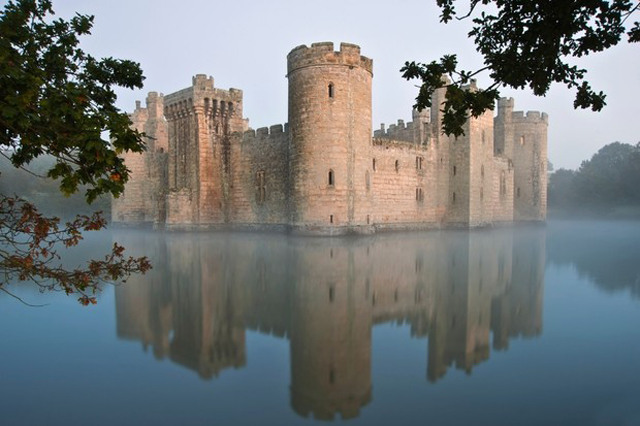
There are many different kinds of movies that stand strong over the years, but what usually stands up the strongest are the ones centered around adventure. There’s something to be said about crowd pleasers that deliver on thrills, both on an intimate and epic scale. Though you can find adventure films that span across all types of genres (fantasy, sci-fi, and so forth) what seems to capture the imagination the most for many audiences are adventures of a historic kind. Human history is full of moments in time that have become the things of legend, and these historical moments in turn provide ample inspiration for cinematic treatment. The historical epic was at one time the most dominant of all genres in Hollywood, especially during the advent of widescreen into cinemas. Historical dramas, whether they be biblical, prehistoric, or medieval, gave Hollywood a chance to show off the craft of their trade on a scale unseen before. They provided production design, costuming, and prop making a chance to indulge in extravagance while at the same time being grounded in a historical context that wouldn’t be too alienating to audiences. But even though these kinds of movies were rousing crowd pleasers, they were at the same time enormously expensive to undertake, and each one would be a gamble once it hit theaters. Over time, the gamble would prove to be too much for the industry, and the historical drama would recede as a force within the industry. But, the movies that we have gotten over the years still stand out as shining examples of Hollywood working with all engines running, and taken out of the context of their performance at the box office, some of these movies eventually do find their audience, especially among those who wish to see epic cinema at it’s most ambitious.
Of the many historical epics that have especially stood the test of time, the most interesting group among them are those set within what we consider the Medieval Dark Ages. This was the period of chivalry, mighty castle fortresses and epic battles between knights in armor. At least that’s what we understand from a majority of the movies made in Hollywood about that time period. But in reality, Medieval times really applies globally, with different parts of the world that shared many different upheavals that defined their history that also could be considered epic in scope. While Europe was in the midst of the rising influence of their warring kingdoms, the Tsars were consolidating power in the Russian steppes, Genghis Khan was continuing his conquest of China and growing his vast Mongol empire, feudalism rose the samurais to ultimate power in the Japanese archipelago, and vast empires were rising in the Americas under the Mayans and the Incas. Though separated by vast distances on the globe, every part of the world was experiencing their own epic stories during these tumultuous times, and they have been the inspiration for some of cinema’s grandest adventures. In this list, I am going to list my own choices for the best medieval movies from across the globe. Keep in mind, I am classifying these movies based solely on their place within a certain historical time and place. Some of these stories can feature supernatural and fantasy elements, but they have to be earthbound, so no fantasy realms with medieval influence will be on this list (The Lord of the Rings, The Princess Bride) and they have to be entirely set in the Medieval times (no Highlander). Before I begin, here are a couple noteworthy movies that didn’t make my list, but are still worth seeing: Black Death (2010), How to Train Your Dragon (2010), A Knight’s Tale (2001), The Name of the Rose (1987), El Cid (1961), Apocalypto (2006), The Passion of Joan of Arc (1928), The Sword in the Stone (1963), Robin Hood: Prince of Thieves (1991), Wolfwalkers (2020), The Court Jester (1955), and The Hidden Fortress (1956). Now, let’s take a look at my picks for the 10 best Medieval movies of all time.
10.
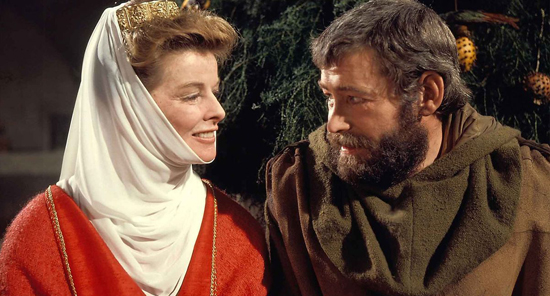
THE LION IN WINTER (1968)
Directed by Anthony Harvey
Not all Medieval movies need to be centered around epic sword battles. In this case, it’s centered around an extremely dysfunctional family who just so happen to be the sovereign rulers of the kingdoms of England and France all meeting together for a Christmas gathering. That’s not to say it’s without it’s own thrilling twists and turns. Adapted by writer James Goldman from his own play, The Lion in Winter centers upon the political machinations of King Henry II of England and his would be heirs. Though the many members of the family come together out of obligations to their familial ties, it’s clear throughout the course of the story that each is trying to outwit one another in a pursuit of power. Henry (played magnificently by Peter O’Toole, who also previously played the same role in 1964’s Becket) has sired another child with his mistress and he seeks to legitimize the child and give him a claim to the throne over his older, grown sons Richard (Anthony Hopkins), Geoffrey (John Castle) and John (Nigel Terry). Complicating the family matters even more are the visiting Prince Phillip of France (Timothy Dalton) and the Queen Mother Elanor of Aquitaine (Kathrine Hepburn), both of whom stir up more disunity within the family for their own quest for power. Taking place over the course of one tumultuous Christmas Eve, the story is an intriguing look at the back-stabbing squabbles of the ruling class. As a movie, it’s a beautifully constructed film with authentic medieval flavor. It’s also a tour de force of acting, with many rising stars like Hopkins and Dalton commanding the screen. But above all else, it is the absolute queen Kathrine Hepburn who commands the film. Winning the third of her four Oscars with her performance here, her presence elevates the movie to epic heights, and really takes her real life historical figure into the realm of legend. Though intimate in scope, The Lion in Winter is nevertheless a Medieval classic in every way.
9.
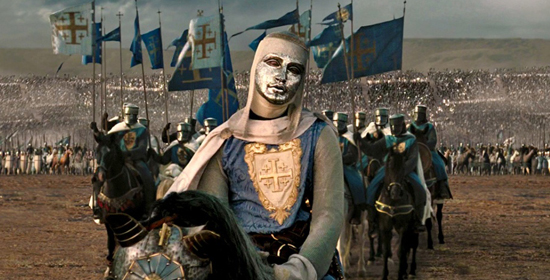
KINGDOM OF HEAVEN: THE DIRECTOR’S CUT (2005)
Directed by Ridley Scott
Taking the opposite direction from The Lion in Winter’s intimate story of inter-family politics, we see here a prime example of epic filmmaking within a Medieval setting ramped up to it’s zenith. Director Ridley Scott had already modernized the sword and sandal epic with his Oscar winning Gladiator (2000) just a few years prior, and he looked to do the same with this Crusades era epic centered around the Battle of Jerusalem. Unfortunately, it didn’t pan out the same way. 20th Century Fox butchered Scott’s original vision to release it in theaters in a more palatable 2 1/2 hour runtime. Sadly, the theatrical cut was an uneven mess that failed at the box office. But, somehow Ridley was able to convince the studio to release his original 3 hour and 15 minute version on home video and audiences were able to see the movie as he originally intended. What we discovered was not only a movie far superior to the one released in theaters, but probably one of the greatest medieval war epics ever made. The character motivations made more sense, the flow of the story was more natural, and it was far more introspective of the themes throughout the story. Written by screenwriter William Monaghan, the story focuses on a lowly farmer named Balian of Ibelin (Orlando Bloom) who through lineage and perseverance finds himself transported from the snowy fields of France to the scorching deserts of the Middle East, where he in turn ends up commanding a defense of Jerusalem from the Sarasin army of Muslim warrior King Saladin (Ghassan Massoud). The epic adventure has all the grandeur you’d expect, but the longer cut also provides an interesting meditation on the morality of war. What Scott and Monaghan do so well in the story is their fair portrayal of both sides in the battle. Saladin is shown to be an honorable leader, as is his counterpart on the Christian side, the leper King Baldwin (a remarkable uncredited and masked Edward Norton), and it’s the Zealot agitators on the edges that are truly responsible for the atrocities of the Crusades. The movie was made in the midst of the ramp-up of the War on Terror, and the movie illustrates the folly of “holy wars” and imperialist nation building. Sadly, the movie that illustrated that the best was left off the big screen in favor of a truncated version free of controversy. At least Ridley Scott was able to get his version seen in the end and it should be the only version anyone ever sees.
8.
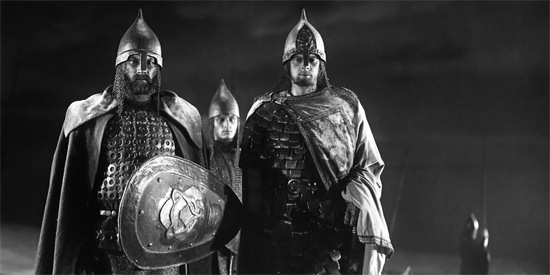
ALEXANDER NEVSKY (1938)
Directed by Sergei Eisenstein
Even the Soviets knew the crowd pleasing force that epic Medieval adventure could have on the big screen. Pioneering filmmaker Eisenstein, who made a name for himself and Russian cinema with silent epics like Battleship Potemkin (1925) and October (1927), continued into the sound era with rousing propaganda adventures meant to spotlight the glory of the Russian worker post Revolution. However, his often extravagant films were criticized as too bourgeois for the more hard lined Stalinist regime. Still, when Russia needed a rousing adventure film to move the masses, he was called upon to deliver. During the 1930’s, the Soviets were concerned by the rising power of Fascism coming from Germany under the reign of Hitler. To convince the Russian people of the evils of Germany, the Soviet regime enlisted Eisenstein to adapt a famous Russian legend of a noble Prince named Alexander Nevsky who successfully defended the Russian people from an invasion from Teutonic (i.e. German) invaders. And deliver he did, with a magnificent Medieval epic that transcends it’s propaganda origins. Alexander Nevsky is one of the most exquisitely crafted epic movies of it’s era, with Eisenstein pushing the limits of scale and drama to the extreme. The production design is top notch, and has even set the standard high not just for Russian cinema, but even that of Hollywood. The harrowing battle on a river of ice is a particular highlight that is still unmatched nine decades later. What is particularly surprising is that Eisenstein was inspired not just by cinema from European contemporaries, but from an unlikely Western source as well; Disney. His staging and camera composition, as well as his use of music, actually owes a lot of influence to some of the more epic cartoons that the animation studio was churning out at the time, including the groundbreaking Snow White and the Seven Dwarves (1937). The Western influence was perhaps too noticeable, because Stalin banned the film for several years after a peace treaty was signed with Hitler’s Germany in 1938. That treaty didn’t last long, and war soon broke out, forcing the movie to be released in full finally, however it was too late for Eisenstein whose good standing with the Soviet government was never able to recover.
7.

SLEEPING BEAUTY (1959)
Directed by Clyde Geronimi, Eric Larson, and Hamilton Luske
Speaking of Disney, they’ve had their own long history with movies in a Medieval setting. With fairy tales being the source of most of their most noteworthy movies, it seems only natural that one or two would be set in a Medieval period. The already mentioned Snow White certainly centers it’s story in a vaguely Medieval, Germanic setting, and Disney also did their own spin on Arthurian and Robin Hood legends with 1963’s The Sword in the Stone and 1973’s Robin Hood. But, if there is one movie that is unmistakably tied to Medieval times in both story and it’s visual aesthetic, it’s Sleeping Beauty. Before you say that I’m bending the rules to include this here, I want to point out that despite the fantasy elements this version of the story is based on the Charles Perrault adaptation, which firmly sets the story of Briar Rose in a distinctly Medieval French setting. And I think above all the other movies on this list, this movie does the best job of conveying the feel of the middle ages through art. Walt Disney wanted this film to look different from any he made before, and in particular, he wanted it to look like a moving medieval tapestry come to life. Long before the Renaissance would revolutionize the art of painting, the most common artform in the middle ages was weaving tapestries for the walls of castles. Within them, they immortalized great achievements by kings and knights, and did so with remarkable, stylized graphic detail. Disney translated this look into the angular, sharp edged style of Sleeping Beauty, which conveys a look of unmistakable medieval influence. The forest scenes alone are spectacular in their attention to the tiniest details. Disney also romanticizes the epic adventure aspect of the story in a way no one else could, with grand palatial castles that seem to extend on forever, and an epic battle between the forces of good and evil that is one of the grandest things ever put on screen. The final battle between the Prince and the evil fairy Maleficent in her dragon form is the stuff of cinema legend. It certainly sets in the audience’s eye the ideal for how a medieval adventure should look, and it certainly does a lot to spotlight just how interesting the artwork of that period was.
6.
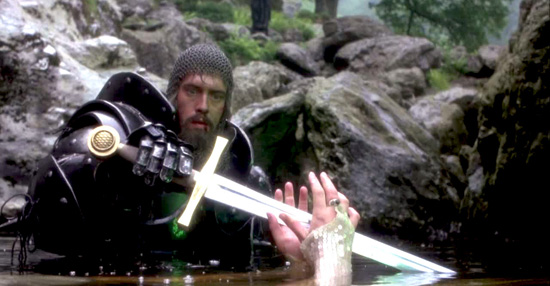
EXCALIBUR (1981)
Directed by John Boorman
Sticking with a segment of the medieval era depicted on screen, we find one of the most imaginative retellings of the legend of King Arthur. The origins of the King Arthur legend and his mythical kingdom of Camelot are still a mystery to many historians, but they are still a large part of the grander cultural identity of the British isles. Much of what we honor as the ideals of the chivalry of knights and their codes of honor stems from the Arthurian legends. And with this version directed by the always unconventional John Boorman, we get one of the most ethereal retellings of the age old legend, while still remarkably staying true to it’s source material. You get all the expected extravagance of a typical medieval epic, as well as some the oddball touches that the Zardoz filmmaker was known for. There’s a half demented Merlin hanging around (played to perfection by Nicol Williamson), a Knights of the Round Table cast that includes Patrick Stewart and Liam Neeson in their earliest film roles, as well as Helen Mirren playing an evil sorceress. But perhaps what makes the movie work as well as it does is the fact that it feels much less like a product of Hollywood and more like the product of an artist trying to convey a true feeling of the story’s medieval roots. Boorman shot most of the movie in real castles in Ireland, and almost all of the movie is on location around these monuments or outside in the surrounding forests. There’s a level of authenticity found here, where the medieval setting feels more lived in, than previous films had ever captured before, and it helped to set a new standard for many of the medieval setting movies that were to come after. You can see from the rise of fantasy films throughout the mid to late 80’s the strong influence of Boorman’s Excalibur. Though Arthurian tales are plentiful in the history of cinema, few have been as influential as this one was.
5.
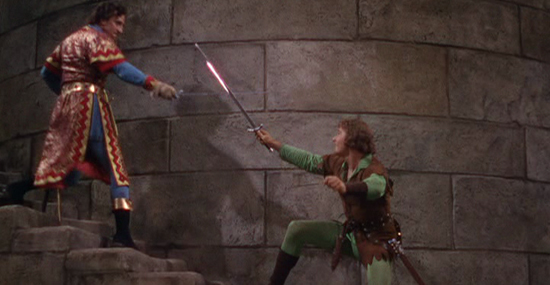
THE ADVENTURES OF ROBIN HOOD (1938)
Directed by Michael Curtiz
On top of King Arthur, the other go to medieval legend that has been a stalwart in Hollywood has been that of Robin Hood. It almost seems like every generation is eager to deliver it’s own new spin on the character, and we’ve seen Sir Robin of Locksley make it to the silver screen dozens of times now. Whether it’s Disney’s fox, the aging version brought to life by Sean Connery, or the different star vehicle versions with Kevin Costner or Russell Crowe, there are plenty that first come to mind when we think of the name Robin Hood. But, if we were to point out the greatest cinematic version of the legendary story, most would point to this adaptation from the Golden Age of Hollywood. Perhaps one of the greatest swashbucklers to ever come out of the Hollywood system, The Adventures of Robin Hood is the epitome of classic Hollywood. With dashing Australian matinee idol Errol Flynn in the titular role, we get a Robin Hood that is all parts handsome, charismatic and worth rooting for. His appeal as a rebellious figure in the face of injustice was particularly poignant for it’s time as both America and Britain were witnessing the rise of Fascism throughout Europe. Making Robin Hood a champion of the oppressed helped to mold this centuries old legend into something that could motivate modern day audiences, much in the same way Sergei Eisenstein was doing at the same time with Alexander Nevsky. Regardless of it’s higher meaning, the movie set the bar high for medieval adventure filmmaker for many years after. Though glossy as most historical movies of that time were, Adventures of Robin Hood is a technicolor extravaganza, with the colors of all the costumes and the sets just leaping off the screen. Though many Robin Hood movies have come after, I don’t think any have come close to being as thoroughly delightful as what what we see here. It’s high adventure at it’s best. Whether he’s swinging from tree to tree, firing arrows at far away targets, or doing one on one battle with the nefarious Sir Guy of Gisborne (Basil Rathbone), Errol Flynn’s Robin Hood stands tall amongst all the rest.
4.
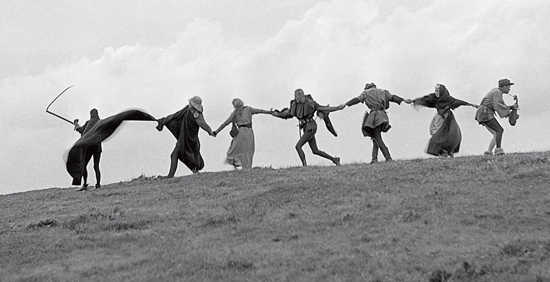
THE SEVENTH SEAL (1957)
Directed by Ingmar Bergman
Now we have a medieval movie that certainly lives up to that moniker. Far from the sugar-coated view of Medieval times that Hollywood presented, Ingmar Bergman’s meditation on mortality is as grim as it gets. Set in the midst of a breakout of the black death across Europe, we follow a set of common people living in Medieval Sweden who are constantly in fear of the specter of death that hangs around them. Death even appears in physical form as a man dressed in black robes (played by Bengt Ekerot) who challenges a knight returned from the Crusades (the late Max von Sydow) to a game of chess. Highly symbolic, Bergman’s story nevertheless is grounded in it’s medieval setting. In many ways, this was the most accurate depiction of life in Medieval times that movie audiences had seen. The hardship of the peasantry struggling to live in harsh times is certainly something that hadn’t been seen on the big screen, as Hollywood was more intrigued by the high chivalrous aspects of the time period. Bergman’s medieval world is harsh, grimey and without much chivalry to speak of. Even Max von Sydow’s knight is treated with much less chivalry than what was coming out of Hollywood. Despite the grimness of the story, Bergman’s Seventh Seal is captivating as our band of characters try their best to stay out of death’s way, which we ultimately learn is a foolish endeavor. Coming out of our most recent pandemic, The Seventh Seal takes on even more relevance, as we see so much civility and normality fall down around us in response to a microbial threat that we are still trying to come to grips with. It’s a still haunting tale that uses it’s medieval setting to glorious effect. In many ways, it echoes the kind of fables that would have been told in those times, which would have been shared in response to hardships that medieval people had to endure. You probably won’t find a more poetic image in cinema than the danse macabre that closes the film, as Death leads our band of characters into the afterlife in an unforgettable hillside parade.
3.
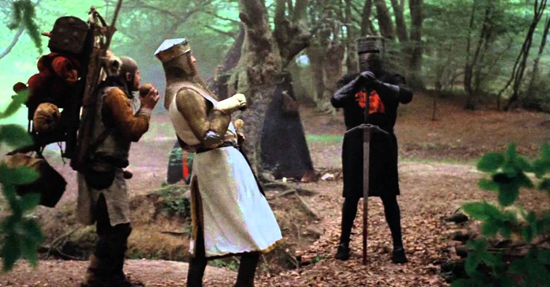
MONTY PYTHON AND THE HOLY GRAIL (1975)
Directed by Terry Jones and Terry Gilliam
And now for something completely different. The legendary comedy team behind Monty Python’s Flying Circus made their big screen debut with this parody of medieval epics, and did so in the silliest way they could. Typical of their legendary irreverent style of comedy, the movie eviscerates every medieval movie trope known. Each new segment of the movie is full of quotable lines and the most ridiculous slapstick, and each has become the stuff of legend in their own right. There’s the Castle of the French Taunters, the Black Knight who defends his post to the point of lunacy, the Knights who say Ni, the viscous white rabbit guarding the cave who can only be bested by the Holy Hand Grenade, and the sexy adventure through Castle Anthrax. Each episode is more ridiculous than the next and showcases the six person squad of comedic geniuses (Terry Jones, Michael Palin, John Cleese, Eric Idle, Graham Chapman, and Terry Gilliam) at their very best. In addition to all the insanity, the movie does feel authentic to it’s medieval roots as well. It’s clear that these scholarly comedians are thoroughly familiar with Arthurian legends, and have a deep understanding of English history as well; all of which gets mocked incessantly throughout the movie. At the same time, the movie’s micro budget actually works in it’s favor, as it gives the medieval setting a more earthbound, lived in feel. Most of the movie was actually shot around a real castle in Scotland, which had to play the part of many different castles throughout the movie. And the on location feel of the movie really helps to make it feel authentic; something Excalibur would also do a few years later with a more substantial budget. Holy Grail is to many the pinnacle of the Monty Python output, and even almost 50 years later it’s still one of the funniest movies ever made. How many people do you know have quoted some part of this movie, from “Tis but a scratch,” to “Go away or I shall taunt you a second time.” But if there is one quote that perfect sums up the insanity of the movie’s medieval setting, it’s, “Let’s not go to Camelot. Tis a silly place.”
2.
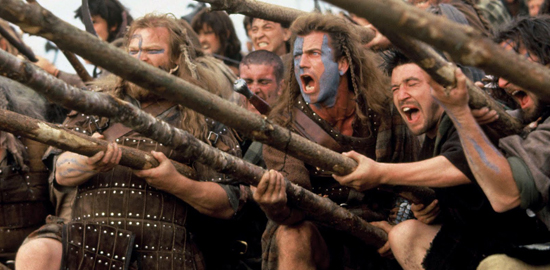
BRAVEHEART (1995)
Directed by Mel Gibson
Putting all the controversy about Mr. Gibson aside, there is no doubt that he captured something unique with his Oscar winning film Braveheart. The only movie with a medieval setting to ever claim the Best Picture prize at the Academy Awards, Braveheart is not without it’s own controversies. Historians, particularly Scottish historians, will tell you that this movie is filled to the brim with historical inaccuracies; to the point of being more fiction than fact. But, given that Hollywood has had a long history of fudging with historical facts to make their stories more entertaining, it doesn’t seem that unusual that Braveheart would do the same as well. And that’s the point behind Gibson’s story about the Scottish rebel known as William Wallace. He wanted to make history into legend and tell a rousing story in the process like the historical epics that Hollywood used to make. And while historians balked, audiences embraced this epic adventure. Many claim it’s even been responsible for revitalizing renewed interest in Scottish independence from the United Kingdom. For the most part, Gibson’s direction does what most great epics of the past have done which is take full advantage of the tricks of the trade that are at his disposal. Before Braveheart, you usually would see epic battles shown from a distance, which allowed the audience to see the vastness of the scene in full. But Mel puts the camera right in the middle of the action on the ground, showing the audience all the bloody mayhem up close. It’s some of the most harrowing combat ever put on screen and in many ways it would set the standard for epic battles for the next several decades. You can see the imprint of Braveheart in everything from Gladiator, to The Lord of the Rings, to even Game of Thrones on television. At the same time, Mel keeps the internal story interesting, with a supporting cast that feels authentically at home in this world. Of special note is Patrick McGoohan as King Edward Longshanks, one of the most unforgettable movie villains ever and a personal favorite of mine. As far as medieval epics go, you’ll be pressed to find one that checks all the boxes as effectively as Braveheart does; one of the absolute benchmarks of it’s genre.
1.
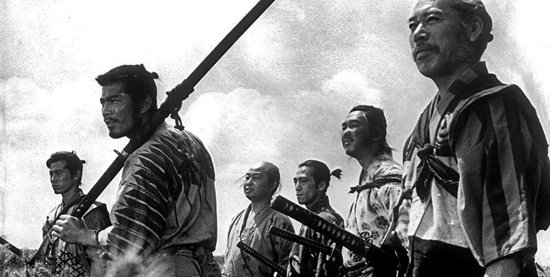
SEVEN SAMURAI (1954)
Directed by Akira Kurosawa
Strangely the greatest movie with a medieval setting isn’t what most people would consider typically medieval. But, out East, while Europe was in the midst of it’s middle ages and saw the rise of kings and knights, the Island of Japan was also in the midst of it’s own feudal rise to prominence. Instead of knights in chain mail and armor, Japan had Samurai who had mastered the art of swordplay. This era too has been mined for cinematic retellings, and out of Japan’s cinema industry rose one of the greatest filmmakers of all time; Akira Kurosawa. Though he worked in genres both historical and contemporary, Kurosawa had an special fondness for this period of his nation’s history and he would return to the Samurai genre many times. Of all his movies set within this medieval period, none stands out more than what many consider (like me) to be his masterpiece; Seven Samurai. Seven Samurai is not a specific fable important to Japanese history, but instead tells a more intimate story of common people trying to survive the hardships of their times. Much like Bergman’s Seventh Seal, Samurai is more about a universal lesson in the nature of mankind that resonates far beyond it’s medieval setting. Even still, Kurosawa tells this simple story in the most epic way possible. The titular samurai all come together to protect a small village from a band of marauders who terrorize them daily, and over the course of the movie, we learn more about them as individuals. It’s a story that can be transposed to any place in the world, and has as it’s been turned into everything from a Western to a Pixar animated film starring bugs. There have even been re-imaginings of it in a medieval European setting, which is appropriate given the time period. Still, the story feels most at home in it’s Samurai genre beginnings, and it showcases just how interesting that period in time was to Japanese, and world history. Though half a world away from where we expect it, the finest example of a movie making the most of it’s medieval setting is found over in the land of the Rising Sun, and that’s first and foremost because it’s not only a great movie within it’s own genre, but one of the greatest movies ever made period.
So, there you have my picks for the best medieval movies ever made. As you can see, I tried to look beyond just Hollywood and see the time period in a more global sense. A lot of these cultures were more interconnected than you’d think, as things like the Mongol Empire and the Age of Discovery connected once disparate cultures faster than ever before. Seven Samurai may be world’s away from the knights in armor epics of Hollywood, but at the same time it still has a lot in common, particularly with it’s themes and the way it stages itself. Kurosawa himself was influenced by Hollywood epics, so it makes sense that they would also take inspiration from him in this cyclical exchange of creative ideas within the global cinematic market. Still, I imagine that when most people think of Medieval set movies, they first will think of the films centered around legends like Robin Hood and King Arthur, and that’s a pretty good assessment of the genre’s identity in all of cinema. Medieval movies are the homes of legends. It’s where we go to find rousing adventures that transport us to a different time and place. As we’ve seen, they’ve been used as powerful propaganda tools like Eisenstein’s Alexander Nevsky, and have also shaped the standards of cinematic art like Disney’s Sleeping Beauty. They also help to turn unknown figures lost in the annals of history into instant legends, like Braveheart did with William Wallace. They are also effective in preserving the legends of the past that we otherwise have little written records of; an effective continuation of oral tradition passed on into modern times. I do wish that the historical epic wasn’t too much of a risk for Hollywood studios to undertake today. There are some that try to revitalize this long dormant genre, like Netflix’s Outlaw King (2018) and The King (2019), and this year we are getting two ambitious twists on the genre with David Lowery’s The Green Knight (2021) and Ridley Scott’s The Last Duel (2021). Hopefully these two succeed in finding an audience and help to prove that medieval epic movies have their place in contemporary cinema. Medieval tales of knights, kings, and yes even samurai, have their place in our culture as tried and true legends, and naturally their movies fulfill that same glory.